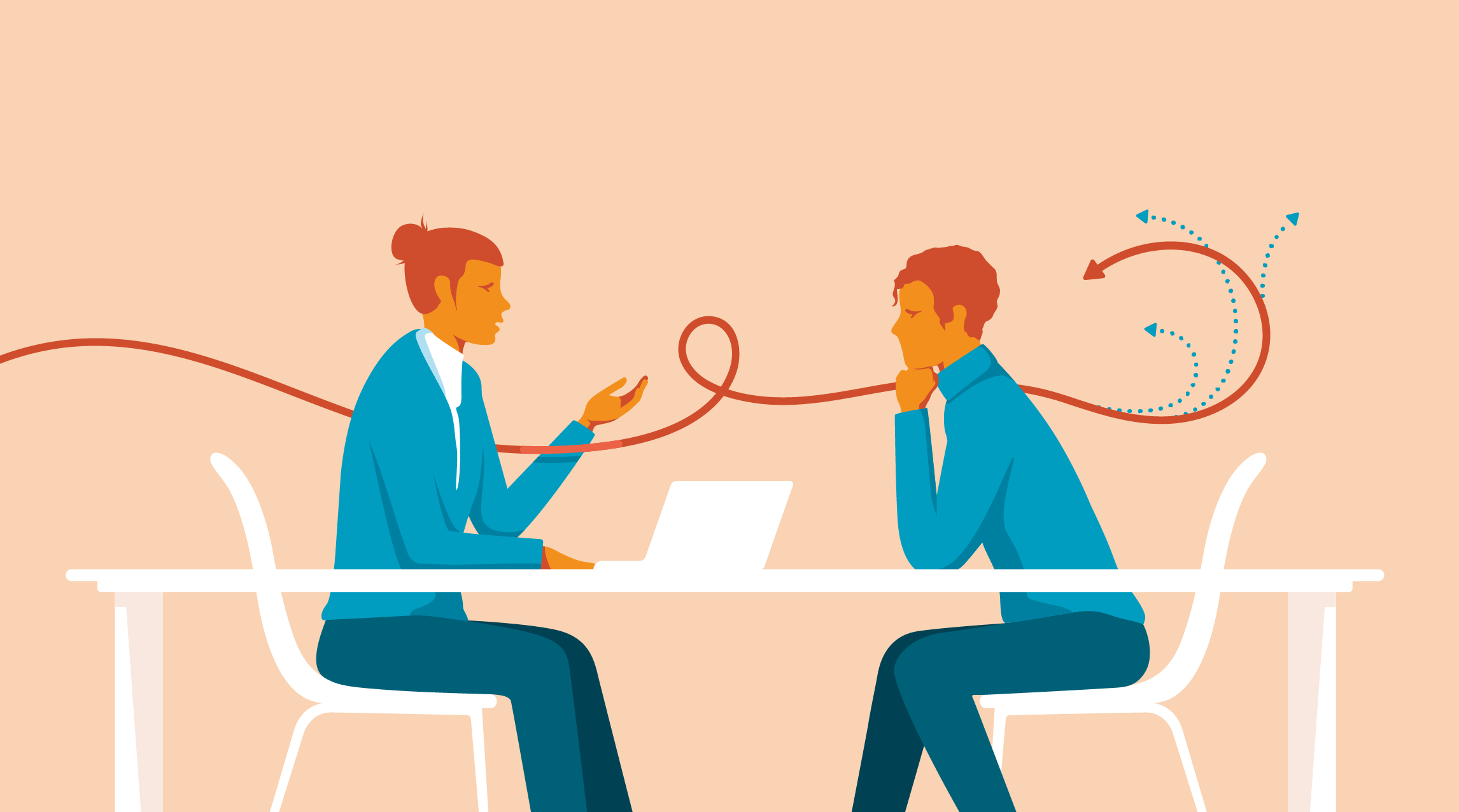Active listening isn’t enough. It’s time for Adaptive Listening™
Published on November 10, 2023

If someone were to ask you, “Which is better in the workplace: active listening or passive listening?” you’d undoubtedly answer “active!” Most people recognize the inherent definition of these listening types. Passive listening is one-way communication where the listener avoids giving feedback or asking questions, and may or may not understand the speaker’s message.
Like when your colleague continues to type on their laptop while you’re telling a harrowing work woe, or when your direct report says “mm-hmm” here and there while you’re speaking, but maintains a blank facial expression – you can tell nothing’s getting through. At its core, passive listening is synonymous with not paying attention. If you’re looking to make a good impression at work, passive listening is probably not the way to go, regardless of your industry, title, or role.
What is active listening?
On the contrary, an active listener makes a concerted effort to understand what the other person is saying. They’re alert, attentive, and engaged. The three components of active listening typically include:
- Showing you’re listening, both verbally and non-verbally by nodding your head, for example, or making eye contact with the person speaking.
- Providing feedback and ask questions when appropriate, like, “Tell me more about that,” or “Why do you think that is?”
- Paying attention by shutting off notifications on your laptop or putting away your phone.
Smart techniques in the workplace, and kind of a no-brainer, right? Sure.
That’s why, over the years, active listening has become synonymous with good listening. Some organizations have even attempted to incorporate active listening exercises into their learning and development efforts, and that makes sense. If given the choice between passive listening and active listening, active wins, no contest. But what if there was an even better way to listen at work?
![]()
Where active listening falls short
With 30+ years of combined experience as communication professionals, my co-creator, Maegan Stephens, and I set out on a mission to develop a model for listening that (unlike active listening) is:
- Purpose-built for the workplace
- Accounts for a fast-paced, results-driven workday
- Considers the nuances of a distributed workforce
After three years of research, hundreds of interviews, and dozens of focus groups and testing in U.S.-based business contexts, we developed a new model for great listening: Adaptive Listening™.
What is Adaptive Listening™?
Put simply, Adaptive Listening™ is processing and responding in a way that meets the speaker’s goals during the interaction. To break down that definition,
- Processing = what you think while you’re listening
- Responding = what you say and show in response
- Speaker = the person speaking to you
- Goals = what the speaker needs from the interaction
- Interaction = the moment you are listening
Adaptive Listening™ challenges, and improves upon, many of active listening’s principles including: avoid judgement, avoid jumping to conclusions, and provide feedback and ask questions, to name a few. While those principles hold true in some workplace situations, they’re simply not appropriate in all environments or with all speakers.
3 big differences between active listening vs. Adaptive Listening™
Here’s a deeper dive into some of the differences between active listening and Adaptive Listening™:
Active listening vs. Adaptive Listening™: Judgement and advice
You might be surprised to learn that active listening was created as a helpful tool for people who listen in a therapeutic setting. Psychologists Carl R. Rogers and Richard Evans Farson published the book Active Listening in the 1950s. As therapists, they wanted to know why some counselors were better than others at addressing their clients’ problems. They found that counselors who listened for “total meaning” across both the patient’s content and feelings had better results than counselors who judged or gave advice.
But outside the therapeutic setting, judgement and advice is often warranted. Across roles and industries, there are situations at work where people are asked to assess, critique, and poke holes in the information. In fact, Duarte Executive Speaker Coaches have made careers out of judging other people’s communication skills and deliverables. We listen to clients and tell them when and how:
- Their presentation is unclear
- Their messages are redundant
- Their delivery skills are distracting
There’s a time and place to evaluate information. And there’s also a time and a place to offer advice. How many times has an executive or senior leader asked for your opinion based on your expertise? Or think about the last time a direct report came to you, confused about how to proceed on their latest project, and you told them exactly how to move forward. You’ve likely had a colleague come to you with an interpersonal work-related issue where they sought your guidance. Sometimes the people you work with need your advice.
In a nutshell
- Where active listening says: “Avoid judgement and advice.”
- Adaptive Listening™ says: “In the workplace, sometimes colleagues need your evaluation, critique or guidance.”
With Adaptive Listening™ skills, you’ll be able to determine, not only when it’s appropriate to provide your evaluation, guidance, and criticisms, but with whom and how.
Active listening vs. Adaptive Listening™: Jumping to conclusions
Active listening also posits that you should “avoid jumping to conclusions.” In the therapeutic context, this guidance makes perfect sense. Counselors and therapists work to give patients time to process information aloud without interruption.
On the contrary, Adaptive Listening™ asks listeners to determine whether the person speaking needs a conclusion jump. Because sometimes they do! In the workplace, jumping to conclusions or interrupting the person speaking might send a message that you’re on the same page. And sometimes, like in agile working sessions or fast-moving brainstorms, that’s precisely what the situation demands.
Can interruptions be a distraction or off-putting? Of course. But when you and a colleague are in a forward-moving rhythm, it might be more efficient and helpful to finish each other’s sentences in the name of progress.
In a nutshell
- Where active listening says: “Don’t jump to conclusions.”
- Adaptive Listening™ says: “Sometimes the person speaking needs you to jump to conclusions for the sake of momentum and drive.”
As an Adaptive Listener, you’ll not only recognize when it’s appropriate to jump to conclusions, you’ll know what to say and how to say it, so those interruptions feel productive, not disruptive.
Active listening vs. Adaptive Listening™: Providing feedback and asking questions
Active listening asks listeners to provide feedback and ask questions. That’s easy to do in a one-on-one listening environment, and again makes sense for therapeutic settings. But Adaptive Listening™ refutes this advice on a few fronts.
First, it’s not always appropriate to provide feedback or ask questions, even if you are in a one-on-one setting. Imagine your senior leader or manager giving you a clear directive. The decision has been made and they simply need you to carry out a task well and on time. That’s probably not the time to push back, probe, or offer your opinion. That’s the time to take action.
It might be even less appropriate to give feedback or ask questions when there are others in the room when you’re listening in a group setting. Sometimes your senior leaders give information for which providing feedback and asking questions might come across as disrespectful, especially in front of other listeners. Instead, it’s time to absorb, retain, and internalize.
In addition, active listening doesn’t account for virtual or digital listening situations, like when you listen to others through a computer screen or when you listen to recordings that don’t involve a live speaker. It can be difficult to know when it’s your turn to chime in with feedback or questions, and how might you even do that when the speaker isn’t in the room with you? Active listening simply doesn’t account for the reality of our new work world.
In a nutshell
- Where active listening says: “provide feedback and ask questions.”
- Adaptive Listening™ says: “Sometimes, but not always.”
Most importantly, as an Adaptive Listener, you’ll know how to give feedback and when. You’ll also learn what types of questions are best for different workplace situations.
It’s time for Adaptive Listening™
To be sure, active listening has made valuable contributions to the therapeutic setting and broader communication contexts. But it doesn’t fully account for the intricacies of your workday. But, if you’re someone who has found success with active listening exercises and techniques, keep using them! Just make sure you add Adaptive Listening™ techniques so you can confidently know when, why, and how to make judgements, give advice, jump to conclusions, ask questions, and give feedback.
For more information on the difference between active listening and Adaptive Listening™, read our upcoming book Adaptive Listening™: How to Cultivate Trust and Traction at Work. And if you’re ready to become an Adaptive Listener, sign up for Duarte’s Adaptive Listening™ workshop. In it you’ll learn about your own listening preferences and goals, how to mitigate barriers that may get in your way of listening to others, how to identify the other person’s goals, and most importantly, how to adapt the way you listen so you can help them meet those goals. When active listening falls short, Adaptive Listening™ might be the solution you didn’t even know you needed.
About the authors
Nicole Lowenbraun, M.S., CCC-SLP
Nicole is a communication nerd who uses her unique speech-language pathology background – and decades of business acumen – to help clients excel in speaking, writing, and listening. With a Master’s in Communication Disorders, Nicole is passionate about fostering more inclusive communication in the workplace. She’s a Content Director at Duarte, Inc. and the proud co-creator of Adaptive Listening™ – the new gold standard for listening in the workplace.
Maegan Stephens, Ph.D.
Maegan started earning her “10,000 hours” back when she was a competitive public-speaker in high school and college (yes, that’s a thing). From there, she sharpened her research skills with a PhD in Communication Studies from The University of Texas at Austin. She is the co-creator of the Adaptive Listening™ methodology and currently leads a team of Duarte, Inc. strategists, writers, and speaker coaches to transform the way people communicate.

TOPICS:
Adaptive Listening™, Communication
RELATED COURSES
RELATED CONTENT
Learn from the pros
Gain insight on effective presentation strategies
From developing presentation skills to designing PowerPoint® presentations, we invite you to join the 200,000 people who leverage our extensive resource library.



